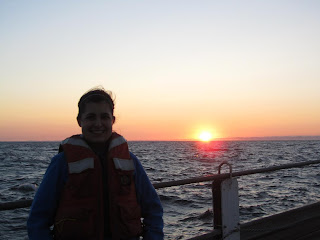Since we have been
doing the same thing every day for a week now, I figured you might be
tired of all the titration business… So I’m going to introduce
you to some of the crew here on the Oceanus!! Since we have the night
shift it is mostly always quiet and lonely because everyone else is
sleeping (except tonight, tonight the lab is hoppin’ with
scientists measuring myctophids!), we had the pleasure of getting to
know some of the crew since there are always people up on watch on
the boat. First thing we do when we wake up is head for food…
obvious.
In the kitchen are
two of my favourite people! Kris and Taylor! Kris probably takes the
cake for my most favorite person on the ship, not just because he
makes the best food ever, but because he really cares about us! Every
single meal there is a “gluten-free” option for myself since I am
intolerant. But it is so much more than that! He gets up around 11pm
every night and makes us a midnight snack, and by snack I mean
delicious meal! Last night there was pizza and it was fantastic. Now
for my favorite part of the day, BREAKFAST. Seriously every single
day there is a fantastic breakfast ready for us when we’re done
working. We’ve even been given the choice for breakfast since we’re
pretty much the only ones who ever come to breakfast… and our
favorite breakfast is French toast. Seriously, I don’t know how he
does it but it is the best breakfast I have ever eaten, and he even
takes the time to bring it over to us at the table where we are
eagerly waiting and giggling (as soon as the sky turns blue we get
really really hyper and excited for breakfast), he even brings over
the maple syrup! REALLY? He is awesome. I’ve had the pleasure of
chatting with him a while too during breaks and what not and he is
such a down to earth person who also happens to love Zac Brown Band!
We really appreciate everything he does for us out here; the cruise
would not be the same without him!
 |
| Kris and I hanging in the kitchen. |
Now Taylor, AKA
Taylor Swift, his partner in crime also works in the kitchen helping
him cook and clean and such, he’s a good guy. Taylor is trying to
learn Spanish, so what do we do? Speak to him in Spanish… or try to
since we’re a little rusty, Kaylyn is much better than I am but it
is still fun.
Now when we are
titrating for hours on end we always are greeted by visitors passing
through as they make their rounds about the boat. A few I have had
the pleasure of getting to know. First, there is Marc, he is one of
the crew I’m not sure really what his job is [Ed: Marc's an AB (able-bodied seaman) meaning he does a little bit of everything on the ship.], but he can be found
fixing things on the boat and making the rounds to see that
everything is a o k! Marc has two beautiful 6 month old twins and he
always has pictures of them to show us, they are seriously the cutest
little things ever! Makenna and Caleb, Caleb always smiling and
laughing in every single picture Marc shows us and the little girl is
known as “miss moody” she is quite the character, and is always
dressed in the cutest little outfits! Marc is also really helpful
when we have questions or want to go out on the bow of the boat in 8
ft seas. He is always there when you need him!
 |
| Marc! |
Another frequent
visitor is Jay he’s the engineer (pronunciation of engineer: ang
–in- eer), he was in the Navy for a while and is a very
entertaining part of the crew he always makes me laugh! He loves
Jimmy Buffet as much as I do and amphi-amphi-amphi-amphipods! When
you’re feeling down he will always bring a smile to your face no
matter what.
Then there is the
Captain, Jeff, he is usually hidden away in the bridge or somewhere
but when he is about he is really funny! Kaylyn and I went up to the
bridge one night to check it out and he gave us the rundown on some
of the equipment, but then we saw on the camera that they caught a
squid so we hurried downstairs to see the catch. But anyways, he is a
great guy.
Well that’s it for
now! I will report back with more later.
Steph























